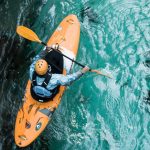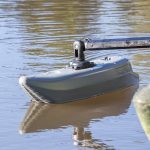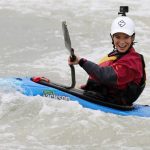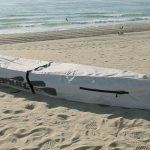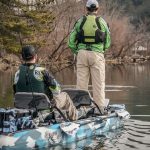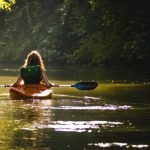Plan to haul a kayak in a truck? Our buying guide will help you choose the best kayak rack. We've also picked some great models for you.
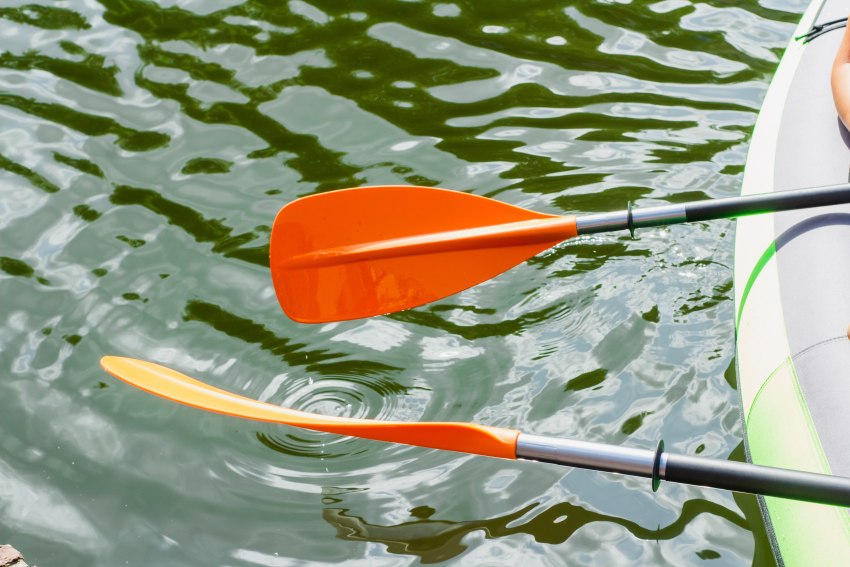
After looking at over 20 affordable kayak paddles, we’ve decided that Bending Branches Whisper is the best budget kayak paddle you can get. Keep reading to find out why.
Cheap doesn’t mean low quality, and budget paddles aren’t just for beginners, either. Many kayakers will go through their whole lives paddling with one of these budget options.
There is a whole load of engineering that goes into making a paddle. In short, the more engineering, the higher the price tag. Beyond our list of the best budget kayak paddles, we’ve broken down some of that engineering to help you decide what you need out of your paddle.
As an affiliate of Amazon and other retailers, we may earn a small commission when you buy via our links, at no additional cost to you. Thank you!
Quick Answer: Best Affordable Kayak Paddles
| Picture | Specs | Where to Buy |
 Bending Branches Whisper | Shaft Material: Aluminium Blade Material: Fiberglass reinforced polypropylene Weight: 37 oz. (1049 g) | Amazon |
| Pelican Poseidon | Shaft Material: Aluminium Blade Material: Fiberglass reinforced polypropylene Weight: 39 oz. (1105 g) | Amazon |
SeaSense Xtreme 2 | Shaft Material: Aluminium Blade Material: Fiberglass filled nylon Weight: 42 oz. (1190 g) | Amazon |
 Best Marine Premium | Shaft Material: Carbon fiber Blade Material: Fiberglass Weight: 33 – 34 oz. (935 – 963 g) | Amazon |
 Pelican Poseidon Angler | Shaft Material: Aluminium Blade Material: Fiberglass reinforced polypropylene Weight: 41 oz. (1180 g) | Amazon |
 OCEANBROAD Kayak Paddle | Shaft Material: Aluminium Blade Material: Fiberglass reinforced polypropylene Weight: 41 oz. (1180 g) | Amazon |
 Carlisle Magic Plus FG | Shaft Material: Fiberglass Blade Material: Fiberglass and polypropylene blend Weight: 39.8 oz. (1128 g) | Amazon |
 Bending Branches Sunrise Glass | Shaft Material: Fiberglass Blade Material: Polypropylene Weight: 35 oz. (992 g) | Amazon |
Perception 3-Piece Hi-life Kayak/SUP | Shaft Material: Aluminium Blade Material: Fiberglass reinforced polypropylene Weight: kayak 57 oz. (1615 g) / SUP 35 oz. (992 g) | Amazon |
 NRS PTK | Shaft Material: Aluminium Blade Material: High density ABS and fiberglass Weight: 42 oz. (1191 g) | Amazon |
Best Kayak Paddles Under $100
Bending Branches Whisper Paddle
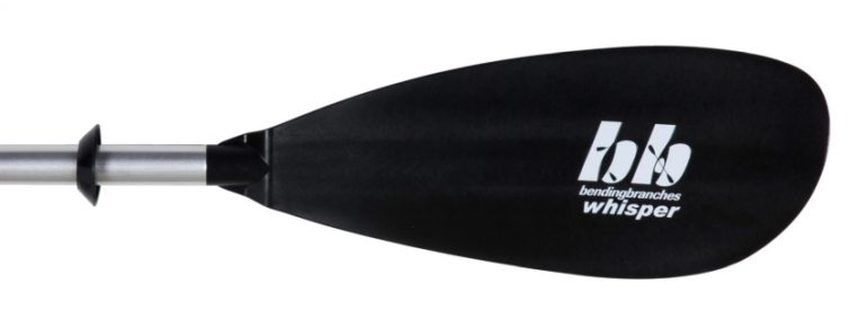
The Whisper is an entry-level paddle from Bending Branches. It has a durable aluminum shaft and strong polypropylene blades. The blades are reinforced with fiberglass for a stiffer, lighter feel. Versafit sections on the paddle shaft give you a comfortable grip and eliminate blisters.
This two-piece construction is connected with a three-hole snap button. This system gives you the option of 0° or 60° feather, either right or left handed. The Bending Branches snap-button technology is wobble free and provides a more secure paddle.
Shaft Material: Aluminium
Shaft Options: Straight shaft. 0° or 60° (Left or Right handed)
Blade Material: Fiberglass reinforced polypropylene
Blade Dimensions: 6.75 x 18 in. (17 x 46 cm)
Blade area: 89 sq. in. (574 sq. cm)
Lengths available: 210 / 220 / 230 / 240 cm
Weight: 37 oz. (1049 g)
Pros:
- Strong, wobble free connection
- Versafit grips on the shaft for a warmer, more comfortable grip.
Cons:
- Some flex in the blades
Pelican Poseidon Paddle

Pelican Poseidon is a low angle paddle with fiberglass reinforced polypropylene blades. Low angle paddling can help to reduce fatigue over longer distances, especially if you paddle a wider boat like many sit-on-tops or fishing kayaks.
The pop-button attachment and two-piece design makes it easy to transport and store this paddle. You can choose between a 0° and 65° feather and rely on a secure fit. Drip rings at either end of the paddle keep your hands dry as you paddle.
Shaft Material: Aluminium
Shaft Options: Straight shaft. 0° or 65° (Left or Right handed)
Blade Material: Fiberglass reinforced polypropylene
Blade Dimensions: Not stated
Blade Area: Not stated
Lengths available: 220 / 230 / 240 cm
Weight: 39 oz. (1105 g)
Pros:
- Arguably the best value for money on this list
- Low angle blades
- Drip rings
Cons:
- Slight wobble in the join
SeaSense Xtreme 2 Kayak Paddle

The SeaSense Xtreme 2 is a two-piece kayak paddle aimed specifically at entry level paddlers. The two-piece design has three locking positions so you can choose your preferred feather.
The aluminium shaft is fitted with foam rubber grips for a more secure hold. Adjustable drip rings keep your hands dry as you paddle.
These paddles are aimed at beginners and are an excellent way to get out on the water without too much investment. However, users have noted that the locking system isn’t entirely secure and the paddle does wobble a little over longer distances.
Shaft Material: Aluminium
Shaft Options: Straight shaft. Three locking positions.
Blade Material: Fiberglass filled nylon
Blade Dimensions: Not stated
Blade Area: Not stated
Lengths available: 213 / 243 cm
Weight: 42 oz. (1190 g)
Pros:
- Cheapest option on this list
- Comfortable rubber grips and rip rings
Cons:
- Rubber grips sometimes come unstuck and move around the shaft
- The connection is not secure and the paddle wobbles
- Heavy
Best Marine Premium Kayak Paddle

The Best Marine Premium Kayak paddle really stands out from the crowd. This is just about the cheapest paddle you will find with a carbon shaft and full fiberglass blades. These combine to give this a level of stiffness not usually found in budget paddles.
These lightweight, two-piece paddles have a secure connection with three feather options. The low angle fiberglass blades are ideal for longer day cruises in relaxed areas. The lightweight design also makes this a great spare paddle, if you choose to progress onto a more advanced design in the future.
Shaft Material: Carbon Fiber
Shaft Options: Straight shaft. Three locking positions.
Blade Material: Fiberglass
Blade Dimensions: Not stated
Blade Area: Not stated
Lengths: 220 / 234 / 250 cm
Weight: 33 – 34 oz. (935 – 963 g)
Pros:
- The most affordable carbon fiber and fiberglass paddle you’re likely to find
- Comfortable and easy to paddle with
- Low angle paddle blades
Cons:
- Limited ferrule angles for a more advanced shaft
- Most expensive paddle on this list
Pelican Poseidon Angler Paddle
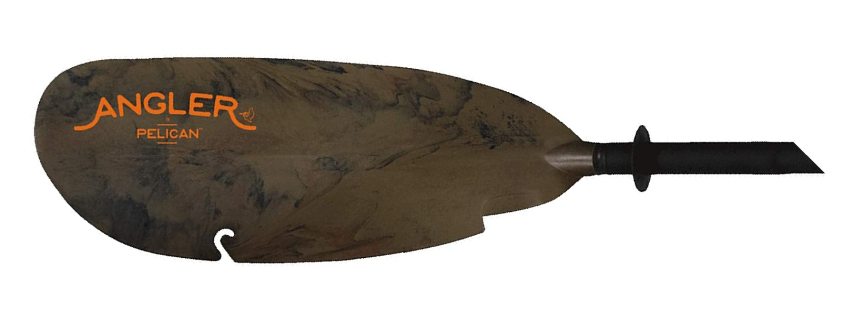
The Poseidon Angler is very similar to the regular Poseidon paddle, but with some extras thrown in for keen anglers. It features the same low angle blades, but on a longer paddle shaft, so you can enjoy a relaxed paddle position for long days cruising around the lake.
RELATED: Pelican Kayaks in 2023: Full Model Lineup and Reviews
The two-piece shaft is easy to transport and store. The anti-slip design means it is easy to paddle, even with wet hands.
A hook retrieval system on the blade and measure along the shaft mean you don’t have to carry excess equipment with you while you fish. This paddle does all the things that more expensive fishing paddles do, but at a much lower price.
Shaft Material: Aluminium
Shaft Options: Straight shaft. 0° or 65° (Left or Right handed)
Blade Material: Fiberglass reinforced polypropylene
Blade Dimensions: Not stated
Blade Area: Not stated
Lengths: 250 cm
Weight: 41 oz. (1180 g)
Pros:
- Good quality budget kayak angling paddle
- Durable and able to withstand long fishing trips
- Low angle blade for cruising between spots
Cons:
- Heavy
OCEANBROAD Kayak Paddle
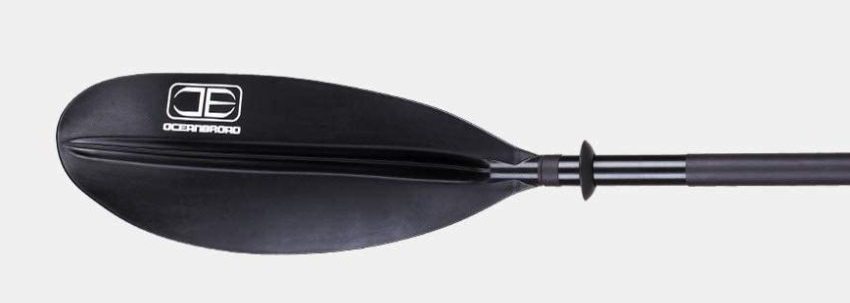
The Oceanbroad Kayak paddle is designed to be a durable, affordable option. The fiberglass reinforced polypropylene blades are low angle and comfortable to paddle over longer distances. The length choices make this paddle suitable for a range of paddlers in a choice of boats.
A polyethylene cover, shrink wrapped tube cover around the aluminium shaft not only makes it more comfortable to hold this paddle, but warmer too. This paddle comes with a leash and drip rings, so you don’t get wet hands as you paddle.
Shaft Material: Aluminium
Shaft Options: Straight shaft. 0° or 60° (Left or Right handed)
Blade Material: Fiberglass reinforced polypropylene
Blade Dimensions: 18 x 6.5″ (45 x 16.5 cm)
Blade Area: Not stated
Lengths: 218 / 230 / 241 cm
Weight: 41 oz. (1180 g)
Pros:
- Wrapped aluminium shaft for warmth and comfort
- Comes with a leash and drip rings
Cons:
- Heavy
Carlisle Magic Plus FG
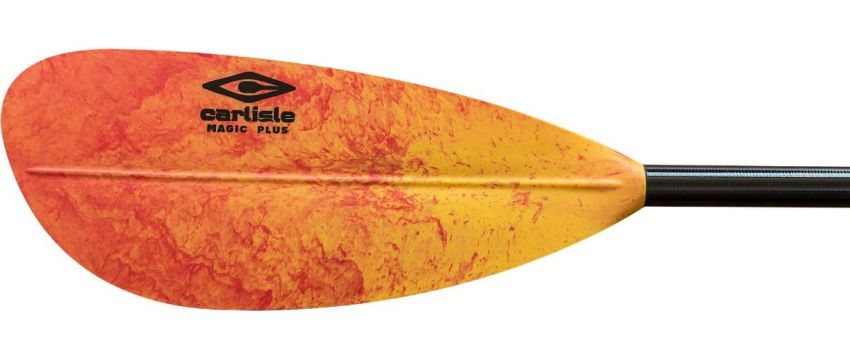
Shaft Material: Fiberglass
Shaft Options: Straight shaft. 0° or 60° (Left or Right handed)
Blade Material: Fiberglass and polypropylene blend
Blade Dimensions: 7.25 x 18 in. (18 x 45 cm)
Blade Area: Not stated.
Lengths: 220 / 230 / 240 / 250 cm
Weight: 39.8 oz. (1128 g)
The Magic Plus is a fantastic option for beginner paddlers who might want to get themselves into a bit of touring, or perhaps some longer recreational days.
The sturdy fiberglass shaft is joined by a solid pop-button ferrule, which gives you options between no feather, or sixty degrees either right or left handed.
Fiberglass and polypropylene blades are strong and durable, while stiff enough that you get a good response and decent power from relatively small blades.
There’s not a load to say about this paddle, it’s a little heavier than most touring paddles, but sits about mid range for beginner paddles. If it had to go into any other list, it would be hard to place between beginner and recreational paddles.
What we like
- Good beginner option, with room to progress
What we don’t like
- Not the lightest paddle on the list
Bending Branches Sunrise Glass
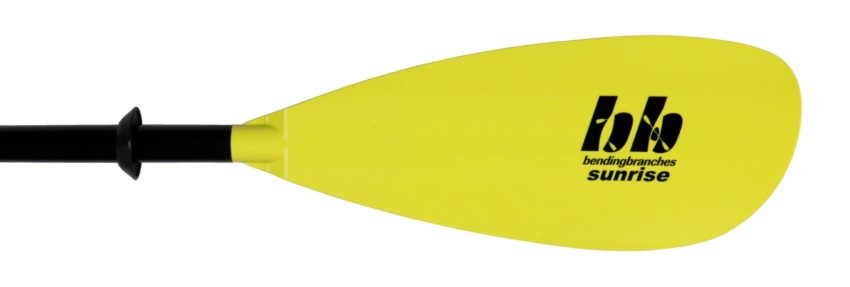
Shaft Material: Fiberglass
Shaft Options: Straight shaft. 0° or 60° (Left or Right handed)
Blade Material: Polypropylene
Blade Dimensions: 6.75 x 18 in. (17 x 46 cm)
Blade Area: 89 sq. in. (574 sq. cm)
Lengths: 210 / 220 / 230 / 240 cm
Weight: 35 oz. (992 g)
The Sunrise Glass is essentially the same paddle as the uber-popular Bending Branches Whisper but with a fiberglass shaft, rather than aluminum. This saves you a couple of ounces in weight, but also makes the whole paddle feel far more responsive and smoother, especially over longer distances.
Beyond that, you still get the solid Bending Branches design which makes them unendingly popular throughout North America.
Polypropylene blades may not be the most technical option, but they will last forever, so you won’t need to worry if you play to push off beaches or bump off rocks as you career down a lazy river.
This is arguably the best of the “under $100” bunch. The blades are a smoother shape than most others on here, and they will feel more like one of the higher level touring paddles than something aimed purely at beginners.
What we like
- Basic paddle with a strong, smooth blade
- Bending Branches are renowned for making solid, quality paddles
What we don’t like
- Polypropylene blades can flutter under power
Perception 3-Piece Hi-life Kayak and SUP Paddle

Shaft Material: Aluminium
Shaft Options: 3-piece shaft. Can be used either as a SUP or kayak paddle. Adjustable length for both.
Blade Material: Fiberglass reinforced polypropylene
Blade Dimensions: Not stated
Blade Area: Not stated
Lengths: One size, adjustable. SUP: 183 – 198 cm. Kayak: 215 – 230 cm
Weight: SUP: 35 oz. (992 g). Kayak: 57 oz. (1615 g)
We’ve included this one as a bit of something different, a crossover which gives you a range of options. This paddle comes in four pieces, and can either be assembled as a kayak paddle, or a SUP paddle, depending on your needs.
RELATED: Perception Kayaks in 2023: Full Model Lineup and Reviews
This could be perfect for anyone with a crossover kayak/SUP model, where you don’t want to be shelling out for one of each. Alternatively, it’s a great spare paddle to carry.
It’s not fancy, that much is fairly apparent. This is a very functional paddle and is perfect for short recreational trips. The aluminium shaft is strong and should last indefinitely, even if it gets squashed or trodden on as you move your kayak around on the beach.
The polypropylene blades are reinforced with fiberglass, to give them a degree of strength and stiffness which means that they can propel you effectively.
This is all great, right? But there are some drawbacks to this crossover design.
Firstly, the blades. They’re stiff and responsive, which is great, but because they’re shaped like a SUP paddle, they aren’t particularly smooth to use when you’re kayaking.
They’re also heavy. Really heavy. As a SUP paddle it’s relatively weighty, but throw that extra blade on the end and you’ve got a robust fifty seven ounces of paddle in your hands. This is fine for shorter trips or for exploring local lakes, but if you’re going further afield, you’ll probably want something lighter.
What we like
- A bit different. Great for a SUP/kayak crossover
What we don’t like
- Heavy. You’ll definitely get a workout with this paddle
- Blade shape is not ideal for kayaking
NRS PTK
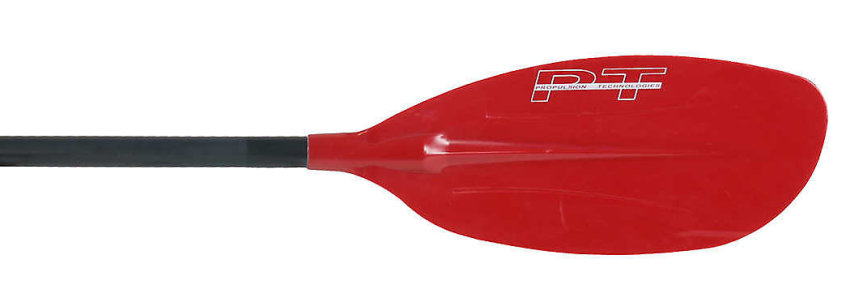
Shaft Material: Aluminium
Shaft Options: Straight shaft. 45° right hand.
Blade Material: High density ABS and fiberglass.
Blade Dimensions: 7.25 x 17 in. (18 x 43 cm)
Blade Area 98 sq. in. (632 sq. cm)
Lengths: 197 / 200 / 210 / 220 / 230 cm
Weight: 42 oz. (1191 g)
The PTK paddle is surprisingly cheap for a paddle which is not only solid, but can span a range of environments. Similar to the Sunrise Glass, the PTK is a step up from a model listed earlier on, this time it’s the NRS PTR.
The PTK retains the same strong, stiff ABS/fiberglass blades, which, unlike polypropylene or nylon blades, don’t flutter or flex. These stiff blades are massive, too, providing far more power than any of the other paddles on this “under $100” list.
The main difference between the PTR and the PTK is the blade shape. NRS have gone for asymmetric, high angle blades for the PTK, and actually they’ve made a pretty smooth paddle in doing so. These blades are not only great for recreational paddling, but can be used for rivers and some very low grade white water, too. They’re pretty versatile for something so cheap.
The issue, if there is one, is in the simplicity. NRS have made the PTK in one model, and one model only. If you like your paddles right handed, and with forty-five degrees of feather, then great. If not, it’s time to move on.
By not having any joins in the paddle, it makes for a strong and sturdy shaft, but the limited option may mean this is aimed more for clubs or schools, where uniformity is sought after, rather than for individual paddlers.
What we like
- Solid and stiff plastic blades
- Can be used in a lot of environments
What we don’t like
- Limited options for feather
Buying an Affordable Kayak Paddle: Factors to Consider
Materials: What Are Kayak Paddles Made Of?
The most expensive paddles are made from the most expensive materials. If you want to cut the costs of your new paddle, consider options made from plastics or paddles with aluminum shafts.
Aluminum
Aluminum is the cheapest and strongest material commonly used for paddle shafts. If you go to any beginner kayak school in the US, chances are you’ll use a paddle with an aluminum shaft. These endure far more use and abuse than any other material.
The price point and robustness make aluminum shafts especially popular with families. They can withstand years of abuse and accidentally being trodden on by small eager feet.
Unlike fiberglass shafts, aluminum has little to no flex. Over longer days of paddling, this can tire your wrists out and potentially lead to long-term issues. Because of this, aluminum tends to be popular among recreational paddlers, rather than those heading out on longer tours.
Plastic
Plastic paddle blades are robust and affordable. These blades are usually nylon, or nylon blended with polypropylene. Some of the more specialist blades are reinforced with fiberglass, which is stiffer than plastic. Stiffer blades make the paddle more responsive, which is useful for direct power and high-pressure strokes.
Flex is the one major downside to plastic blades. Any power lost to flex is wasted energy. In situations like whitewater or sea kayaking, this can be detrimental to your day, and paddlers in these environments may choose a stiffer paddle instead.
Plastic blades are also heavier than fiberglass or carbon alternatives. Mostly, this will go unnoticed, unless you have a particularly heavy set of paddles or are out on a long tour.
Fiberglass
Fiberglass is commonly used as both the shaft and the blade material. It’s unlikely that you will find many budget paddles with fiberglass shafts as these stiffer, lighter blades tend to be more high-end.
Fiberglass shafts are often found on paddles which could be considered budget-specialist (if such a thing exists). These are often paddles toward the entry-level for white water, sea kayaking, or kayak angling.
Fiberglass blades are comfortable to use and lighter. They also have more flex than aluminum. A fiberglass shaft is a better long-term option than aluminum, putting less strain on your wrists. These shafts are commonly paired with plastic, fiberglass, or carbon blades.
Carbon
It’s unlikely that you’ll find a carbon paddle that falls into the budget category. Anything made from carbon tends to attract a high price point and paddles are no exception.
We only need to cover these briefly then. Carbon paddles are stiffer, lighter, and more responsive than any other material. Carbon shafts are common on mid-range specialist paddles, but carbon blades are only found on top-of-the-range models.
Paddle Length: What Size Of Kayak Paddle Is Best?
Paddle length rarely affects the price of a paddle directly. It is still vitally important that you get the right length of paddle, though. Paddles which are the wrong size can be difficult to use and can eventually lead to injury or muscle strain.
Different styles of kayak require different lengths of paddles. Equally, people of different heights require different paddles.
Narrower kayaks, like touring or sea kayaks, require shorter paddles. Wider kayaks, like fishing kayaks or sit-on-tops, require longer paddles to reach the water comfortably. Some two-piece paddles come with adjustable length shafts, but these will command a higher price than fixed-length paddles.
Blade Shape
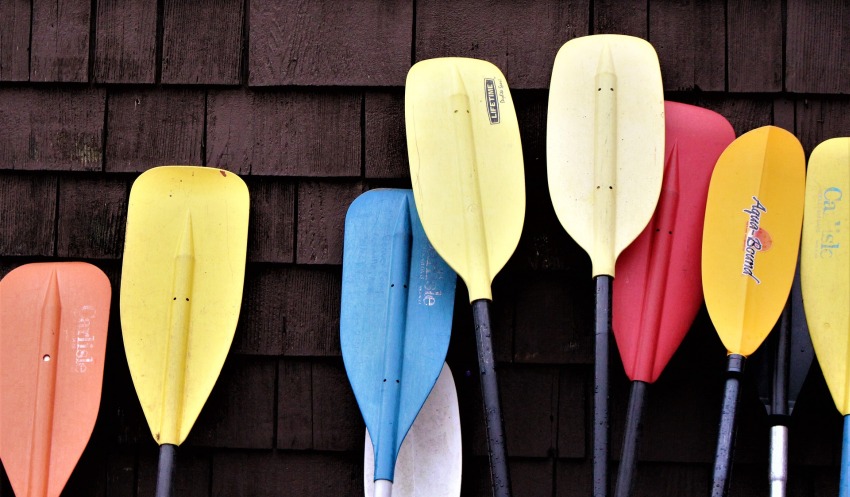
Kayak blades come in all sorts of shapes and sizes. The most basic and usually cheapest option is the traditional square shape blade which looks like a rowing oar. These square, symmetrical blades are designed to be as user-friendly as possible.
They do have limitations, though. Symmetrical blades are easy to use but unrefined. They do not pull cleanly through the water and are tiring over longer distances.
Asymmetric blades have different blade areas above and below the shaft. These are usually some form of teardrop shape and are designed to be used in a particular way. Asymmetric kayak blades are more ergonomic, meaning they’re nicer to paddle with, especially on longer journeys.
Within these asymmetric blades, there is a choice of high-angle or low-angle. These don’t necessarily alter the price enormously and we won’t get too technical, but we’ll briefly look at each.
High-angle kayak blades are designed for power and drive. They tend to work best with narrower kayaks and are used in white water or ocean surf.
Low-angle blades are more suited to long, cruising paddle strokes. They are popular with anglers and touring kayakers. The relaxed style still generates a lot of power, but less directly than the high-angle blades.
Kayak blades are usually scooped, if only a little. Flat kayak blades are always the cheapest, but you lose a lot of power to not having the scoop. Even most budget options will come with a slight concave/convex shape to them.
One-piece or split paddles
One-piece kayak paddles are the most affordable option on the market. Split paddles require more engineering and therefore cost more money. However, you can still buy budget split paddles.
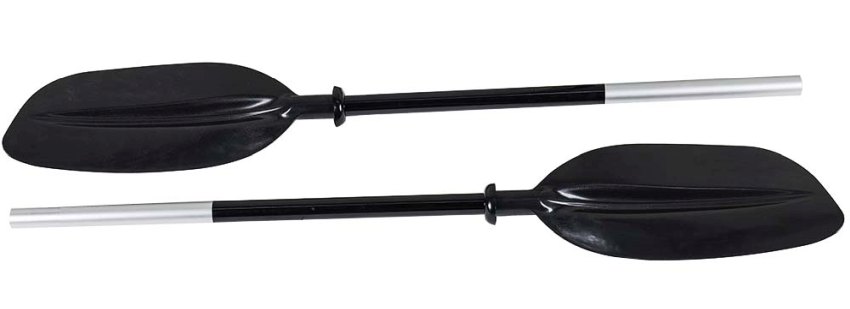
The benefit of split paddles tends to be in storage and transport, but they are also useful as some come with adjustable length or angle. Cheaper split paddles tend to use push-button fixtures, which are secure but offer limited options.
The higher-end split kayak paddles use a range of technical fixings and can have infinite variable angles and a choice of lengths. While these may be more expensive, buying one paddle which can suit a range of paddlers may work out more affordable in the long run, rather than buying multiple paddles.
Final Thoughts
Paddle quality doesn’t always have to be costly. It can be easy to get carried away buying your kayaking essentials, but you don’t have to break the bank to get yourself the right paddle. We hope this list of the best budget kayak paddles helps you make your decision easier.


